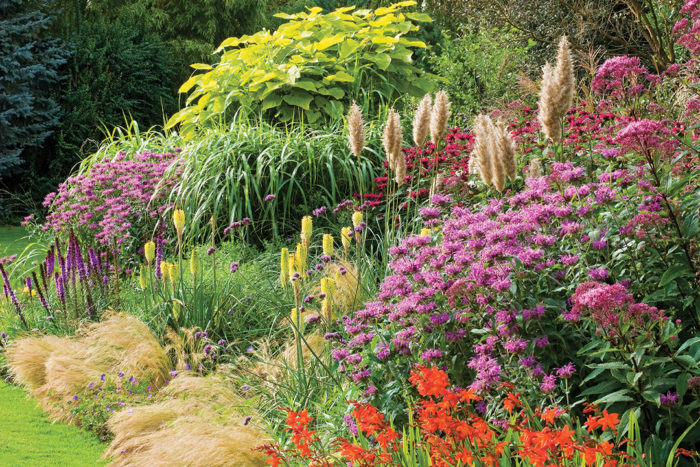
While most people tend to divide the gardening year into four seasons, I like to divide it into three time periods: planning, working, and enjoying. Winter is for planning. It’s when you really don’t want to be outside and when your time is better spent formulating the plan of attack to make your garden the best it can be. Spring is the working time period, when the bulk of your cleanup, planting, and projects get done. Fall is also a working period and is generally when you can revisit the things you didn’t get done in spring.
But in between those two times of intense work is the enjoyment phase. Arguably, this is the most important. For some reason, I never feel like my garden looks the best it can during this time period—which is really sad, since this is when I spend my time sipping margaritas outside. The combos in this article have inspired me to up my game, though. So next year when I’m pouring tequila in my glass, I’ll be simultaneously admiring a garden that’s at its pinnacle.
Tone down orange with a bit of burgundy
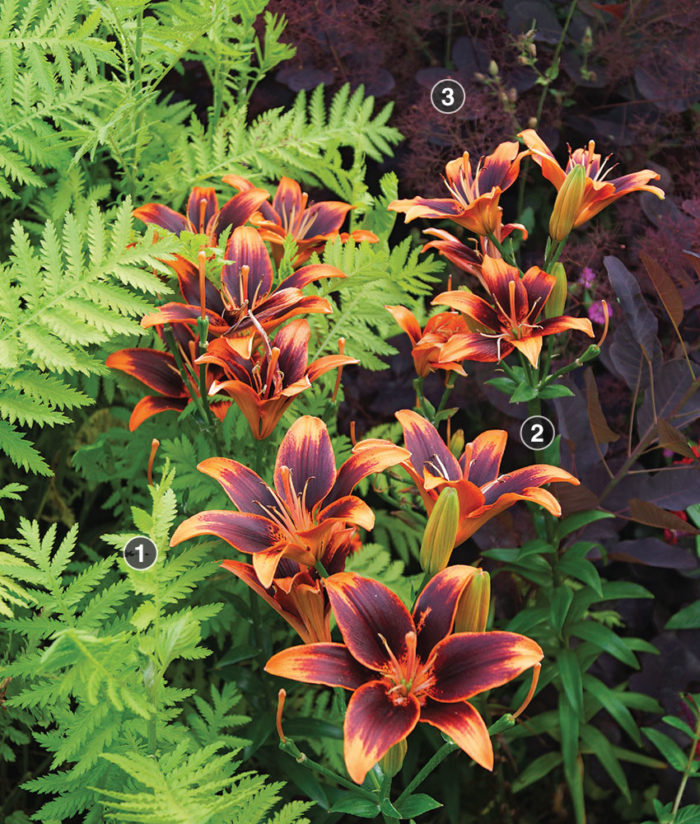
Nothing says good-bye spring and hello summer like the warmth of orange. But this vibrant color can stick out in a bad way if not given the proper companions. Here, the dark smoke tree foliage helps mellow things out, while the lime-leaved tansy makes sure things still stay somewhat lively when the lily goes out of bloom.
Key colors 
- ‘Isla Gold’ tansy (Tanacetum vulgare* ‘Isla Gold’, Zones 3–8)
- ‘Forever Susan’ lily (Lilium ‘Forever Susan’, Zones 4–8)
- ‘Royal Purple’ smoke tree (Cotinus coggygria ‘Royal Purple’, Zones 4–8)
*See invasive alert below.
Romantic colors always go well together

Much like Romance languages bearing a recognizable similarity to each other, romantic colors share a commonality that makes them perfect for pairing. Dreamy violet, feminine pink, and sultry red (all of which are regularly referenced in sappy romance novels) form a dynamic grouping when the temperatures begin to rise.
Key colors 
- ‘Jacob Cline’ bee balm (Monarda ‘Jacob Cline’, Zones 4–8)
- Meadow rue (Thalictrum rochebruneanum, Zones 4–7)
- Queen of the prairie (Filipendula rubra, Zones 3–8)
- Persicaria (Persicaria cv., Zones 4–7)
Light colors can calm things down
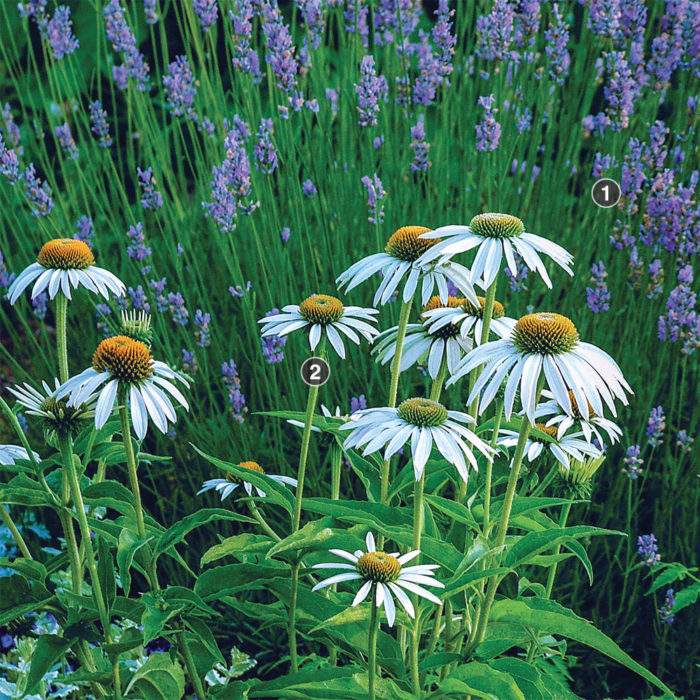
Not every peak combo needs to consist of loud-colored plants. White can have just as much impact, although it works especially well when its companions are also in soothing tones. Here, the lavender continues the pale-colors theme into the back of the border.
Key colors 
- ‘Provence’ lavender (Lavandula × intermedia ‘Provence’, Zones 5–8)
- ‘White Swan’ purple coneflower (Echinacea purpurea ‘White Swan’, Zones 3–8)
Design Tip: It’s best to deadhead white coneflowers, because the spent blooms look like dirty tissues when they fade.
Keep your plants blooming by learning how to do the Chelsea Chop.
If the palette is hot, mix in some neutrals to keep it from boiling over
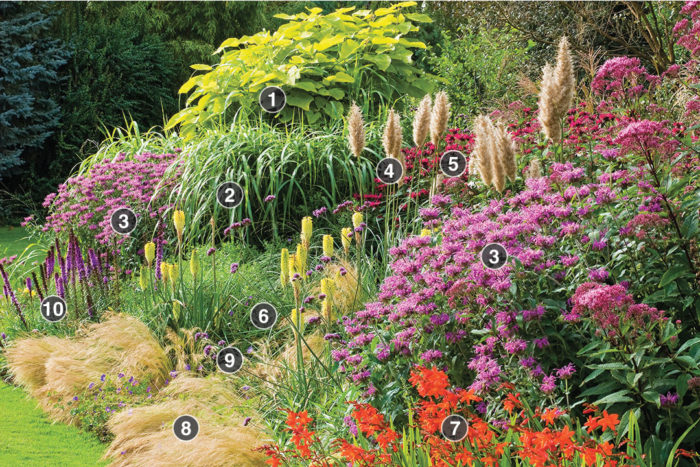
Bright yellow, blazing orange, and hot pink are truly the colors of summer. But combining them can be too garish without some neutral tones such as taupe, buff, or brown mixed in to separate the colors and mellow things out just a bit. In this case, an array of ornamental grasses ensures that everyone plays together nicely.
Key colors 
- Golden catalpa (Catalpa bignonioides* ‘Aurea’, Zones 5–9)
- ‘Super Stripe’ miscanthus (Miscanthus sinensis* ‘Super Stripe’, Zones 5–8)
- ‘Violet Queen’ bee balm (Monarda ‘Violet Queen’, Zones 3–8)
- ‘Patagonia’ pampass grass (Cortaderia selloana* ’Patagonia’, Zones 8–10)
- ‘Raspberry Wine’ bee balm (Monarda ‘Raspberry Wine’, Zones 3–8)
- ‘Percy’s Pride’ red hot poker (Kniphofia ‘Percy’s Pride’, Zones 6–9)
- ‘Constance’ crocosmia (Crocosmia × crocosmiiflora ‘Constance’, Zones 6–9)
- Mexican feather grass (Nassella tenuissima, Zones 7–10)
- Tall verbena (Verbena bonariensis, Zones 7–11)
- ‘Kobold’ blazing star (Liatris spicata ‘Kobold’, Zones 3–8)
*See invasive alert below.
Purple and orange make a statement
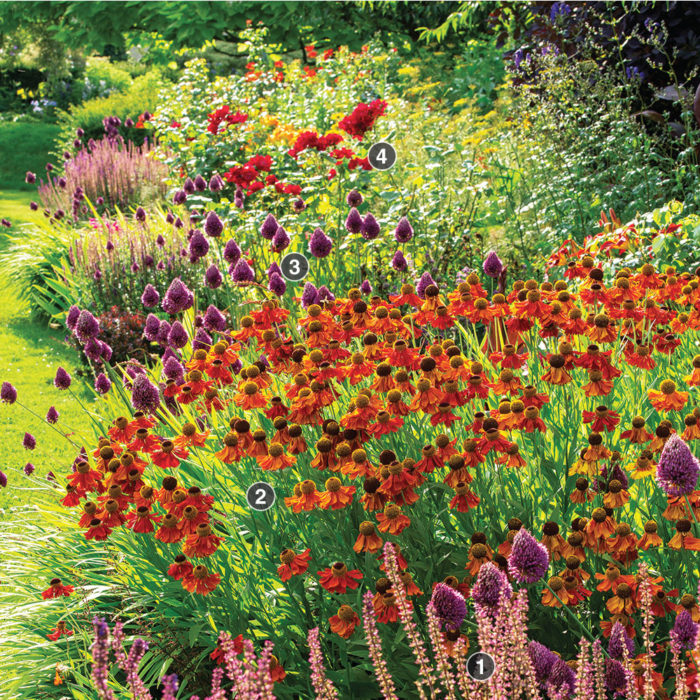
Contrasting colors work well together, but do analogous colors? This grouping proves that the answer is yes. The rusty orange of the sneezeweed might have looked a little too 1970s if it weren’t for the pop of energy it gets from the surrounding purple blooms.
Key colors 
- Salvia (Salvia cv., Zones 4–9)
- ‘Sahin’s Early Flowerer’ sneezeweed (Helenium autumnale ‘Sahin’s Early Flowerer’, Zones 4–9)
- Drumstick allium (Allium sphaerocephalon, Zones 4–8)
- Rose (Rosa cv., Zones 4–9)
Blooms aren’t the only way to get attention
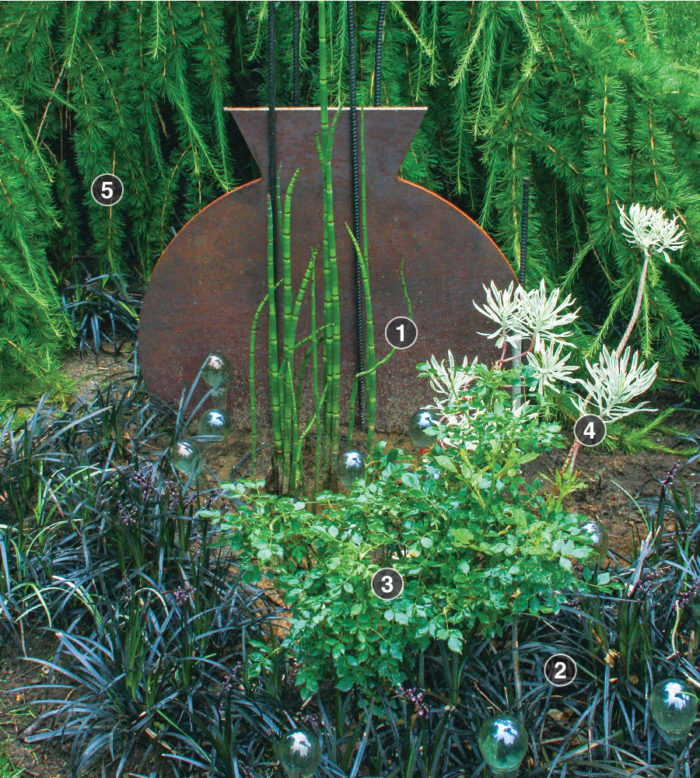
This grouping is all about texture. Because early summer can be a time of variable weather, you’ll never need to worry about bloom times when you rely on texture for interest. From the fine-needled larch to the fleshy euphorbia, this black-and-green combo is never lacking. When the rose in the middle finally does flower, it’s just an added bonus.
Key colors 
- Rough horsetail (Equisetum hyemale, Zones 4–9)
- Black mondo grass (Ophiopogon planiscapus ‘Nigrescens’, Zones 6–9)
- Rose (Rosa cv., Zones 4–9)
- ‘Tasmanian Tiger’ euphorbia (Euphorbia characias ‘Tasmanian Tiger’, Zones 7–9)
- Weeping European larch (Larix decidua ‘Pendula’, Zones 3–6)
Design Tip: Horsetail can be quite aggressive in wetland areas. This one is kept in check by placing it in a pot in the ground.
Green combos are subtle yet long lasting

A sure bet for a winning combination is taking one hue and pairing it with various shades of that color. Green can be the easiest to work with since it’s so prevalent in the garden. Here the lime green elephant’s ear leaves really pop against the dark and moody ligularia foliage, which also allows the pale green sweet flag to shine.
Key colors 
- Sweet flag (Acorus calamus ‘Variegatus’, Zones 4–9)
- ‘Othello’ ligularia (Ligularia dentata ‘Othello’, Zones 3–8)
- ‘Lime Zinger’ elephant’s ear (Xanthosoma ‘Lime Zinger’, Zones 8–10)
When in doubt, mix in some tropicals

As early summer gives way to the sizzling days of late summer, you can always count on tropical plants like canna, elephant’s ear, cigar plant, and scented geraniums to come into their own. Grouping brightly colored, tender treasures like these ensures a bold statement.
Key colors 
- ‘Black Magic’ elephant’s ear (Colocasia esculenta* ‘Black Magic’, Zones 8–10)
- ‘Pretoria’ canna lily (Canna indica ‘Pretoria’, Zones 8–10)
- ‘Charity’ scented geranium (Pelargonium ‘Charity’, Zones 8–11)
- Firecracker plant (Cuphea cv., Zones 7–10)
- ‘Crimson Pygmy’ barberry (Berberis thunbergii* ’Crimson Pygmy’, Zones 4–9)
- Lambs’ ears (Stachys byzantina, Zones 4–8)
*See invasive alert below.
Danielle Sherry is the senior editor who loves margaritas almost as much as gardening.
Photos, except where noted: Danielle Sherry
*Invasive alert: Tansy (Tanacetum vulgare)
This plant is considered invasive in CA, MT, and WA.
Invasive alert: Catalpa (Catalpa bigonioides)
This plant is considered invasive in NJ.
Invasive alert: Miscanthus (Miscanthus sinensis)
This plant is considered invasive in CT, GA, IL, IN, KY, MD, NC, NH, NJ, NY, PA, SC, TN, VA, and WI.
Invasive alert: Pampas grass (Cortaderia selloana)
This plant is considered invasive in AL and CA.
Invasive alert: Elephant ears (Colocasia esculenta)
This plant is considered invasive in AL, CA, and FL.
Invasive alert: Japanese barberry (Berberis thunbergii)
This plant is considered invasive in CT, DE, IA, IL, IN, KS, KY, MA, ME, MD, MI, MN, NH, NJ, NY, OH, PA, RI, TN, VA, VT, WI, and WV.
Please visit invasiveplantatlas.org for more information.





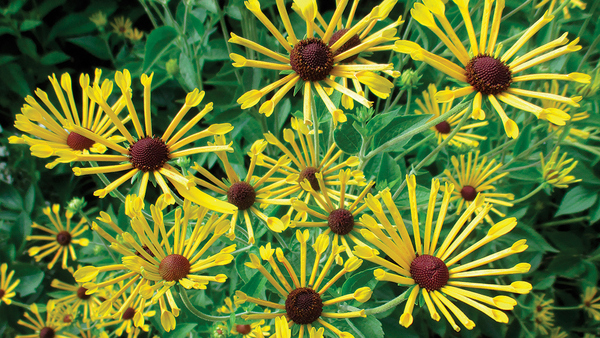












Comments
Log in or create an account to post a comment.
Sign up Log in